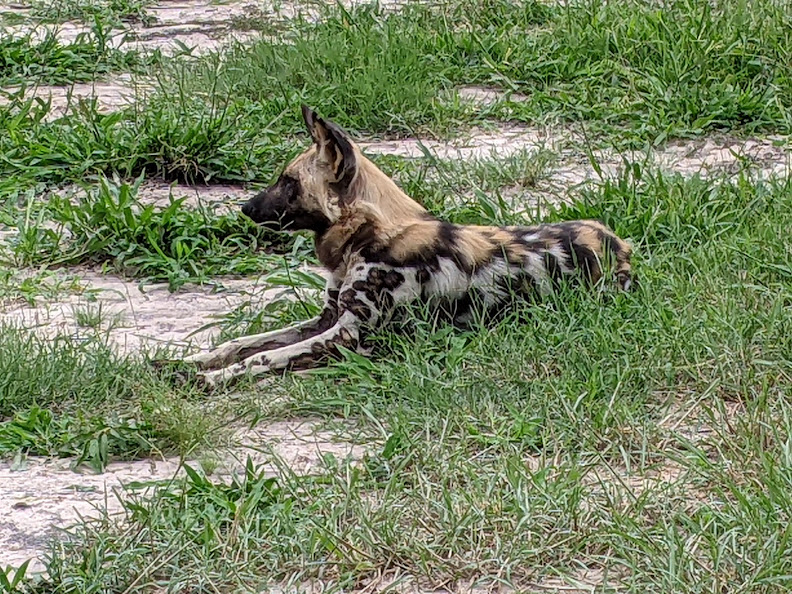The difference between Old Drift and Splash Camp can best be defined in two examples. First, Old Drift has a phone in the room, with a five digit number to reach the office if you need anything at all, at any time of the day or night. Splash Camp has no phones at all, including cell service. Instead, they give you an emergency horn to honk for assistance if you are sick or injured at night, which will summon somebody to help you. (It helps if you also turn on your lights so they can see who honked the horn.)
Short of an emergency, however, once you go to your room for the night you’re not getting anything from outside it until morning. You’re not allowed to leave the room after dark without a staff escort, for safety reasons, and you have no way of asking for an escort except that horn. So unless you have a serious enough emergency to use your horn, wake the whole camp, and bring half the staff running in a panic, you retire for the night and that’s it until the dawn.

Second, in the 45 minutes drive from Kwara Airstrip to Splash Camp, I saw two species of antelope that I hadn’t seen before (the Tsessabe, and the teeny tiny Steenbok, which , when full grown, is about the size of a baby impala). That’s before any game drives — we were just getting to camp from the airport. We also saw giraffes, including a baby lying down in the grass, some beautiful birds, and a lot of zebras.
Old Drift was a luxury lodge, surrounded by a national park. And as a luxury lodge, it did a wonderful job. Splash Camp tries to be as comfortable as reasonably possible under the circumstances… but it isn’t in a park. It is in the bush, the actual wild, and there are technological limitations to running ba facility in this place.
The tradeoff is that the wildlife is out of this world. And that’s why the camp is here. They’ve made a conscious decision to prioritize the wildlife in every single case where a choice has to be made. That leaves the comforts respectable but certainly not luxury… but the wildlife is spectacular.
TJ, the guide, and KP, the tracker, met me at the airport. They told me that there would be four additional guests the next day, but that for now I was the only one, so I would get two private game drives before the others arrived. And they asked, as all good guides do, what I had come here hoping to see. What would make my stay truly special?
I had trouble answering that question, because I know that nature gives what it chooses to give, and I didn’t want to make the guides feel bad if they couldn’t produce what I requested. I told them that I liked antelopes and would be happy to see as many different kinds as possible… and then I finally acknowledged that the two species I was really hoping to have a chance to see were the African wild dog, and the cheetah.
They admitted that those might be difficult to find, especially in the rainy season, when the grass grows tall and the herbivores can feed anywhere, which means the carnivores also might be anywhere. But they said they’d try. Of course I also explained all about the Battle of the Elephants, and they said they’d try to find those for me too, and that would doubtless be easier.
TJ and KP are both members of the San people. They grew up near here, with their days spent in the wild and their fathers and older brothers teaching them about the bush and its creatures. TJ said he tried an office job once and hated it. Finally he gave up on that kind of life, and took up a career that would keep him outside among the wild things he loves. Both TJ and KP have an incredibly keen eye for wildlife, and a deep knowledge of how it behaves and where it can often be found.

We arrived at camp, and I had orientation and lunch, and then was shown to my room. It was pleasant but rather spartan compared to the luxury of Old Drift. I found that I didn’t mind (I began to mind a little more a few days later, when everything hurt). An hour or so later, we set out into the bush. We were looking for elephants, and TJ thought he knew where to find them. Only fifteen minutes into the drive, he was proven correct — we found a small breeding herd, made up of females and young ones. A couple of elephant youngsters kicked up their heels between a pair of carefully watchful adults. One of the older females, whom TJ thought might be the matriarch, stood a little ways off from the rest and looked at us, very seriously. You could see her ears just slightly extended, ready to flare with warning if we ventured too close. We didn’t.

Shortly after we moved on from that herd, we saw another, much bigger, group of elephants. This time it appeared to be made up of two different herds, eating together. There was a brief flurry of action as one female drove another and her baby away from the bush they’d been munching. TJ said they were from one herd, and the aggressive elephant was from the other, and she thought they were getting too close. The exiled elephant and her baby moved cautiously away.
From then on, everywhere we looked there were more elephants. It got pretty silly after a while. After searching for two days with no elephants, we couldn’t turn around without seeing elephants! I was enjoying them immensely, but still vaguely wondering whether we would ever see anything else, when KP suddenly whispered excitedly “Dog! Dog! Dog!”

KP was exactly right. There they were: dog, dog and dog; one, two three. Only three of them made for quite a small pack, but TJ explained that he had seen the male as part of a larger pack several months ago. He thought this group had split off, probably because the alpha male and female had grown tired of being subordinate and decided to strike out on their own. The other female, probably the first one’s sister, had followed them.
The wild dogs of Africa, never-domesticated canines who live and hunt in packs like small wolves, were one of the species I had most wanted to see on this trip, but I knew it wasn’t terribly likely. They’re quite rare, and they move over a huge territory, so it’s easy for a guide team to lose track of where they are. This pack had been seen in the area before, but frequently moved in and out without offering the staff their forwarding address. We were incredibly lucky to run into them.

We sat with the dogs for a long while, even after we called to another van from their sister camp to come and see. The dogs were very relaxed, just lying around beside the pool of water, resting and listening for the sounds of anything interestingly edible to come to them on the wind. They were absolutely beautiful, especially the male — brindle and cream markings that make it easy to see why one of their names is “Painted Dogs.”
When we finally moved on, we continued to play dodge the elephants — they really were everywhere we looked. We began joking that the reason I hadn’t been able to see any elephants in Zimbabwe over the last few days was that every last one had emigrated to Botswana and were waiting for me here. After several tries, TJ finally thought of a spot for sundowners that he was pretty sure had no elephants in it. We’d been there earlier, when we first began looking for elephants, and there weren’t any present. So we went there.
And, in fact, there were no elephants. It was the one place in the past two hours where there were no elephants. Instead, there was a lion.

A big male lion with a gorgeous mane lay on the ground, his belly distended from a huge meal very recently. He clearly intended to nap off his oversized dinner, and eyed us balefully, but he was too sleepy to bother registering a serious objection to our presence. We decided nevertheless that this was not a great place for sundowners, but we did stay there for a little while to watch that lion. Then we went on. We finally found a spot for sundowners which did, in fact, contain elephants… but at enough of a distance that we could safely get out of the van. So we had our drinks while watching a couple of young and socially clumsy bulls see how close they could get to the cows before the cows chased them away. They were pretty funny. Eventually, the cows left, and then after a while one bull followed them, and then the other looked up and clearly thought, “Hey, where’d everybody go?” before ambling off in the same general direction himself.

After the dogs and the lion, pretty much anything would be anticlimactic, and the rest of the drive was. But it was still fun. We stayed out after dark (something we weren’t allowed to do at Old Drift, because it’s inside a national park with a curfew), and saw a few of the night creatures that rarely get much attention. With the safari vehicle, we accidentally flushed a nightjar who’d been sitting in the road — a type of nocturnal bird I had never heard of before. A small creature called a spring hare popped out of its burrow and bounced right past KP’s spotlight. They have very short front legs and very long hind legs, and look a little like a cross between a rabbit and a jerboa.
And we STILL kept running into those elephants — sometimes almost literally. They are surprisingly difficult to see in the dark despite their size, because they’re dark gray and tend to hang out (when they can) in areas with a lot of bushes and trees. We blundered within five feet of a big female before we saw she was there — and worse, her whole herd were all around us! Fortunately, she and her herd were regulars in this area, who knew the camp and its trucks very well. She didn’t panic or we might have been in trouble. She just made a mild noise of protest, and they all moved away. So did we.


Leave a Reply